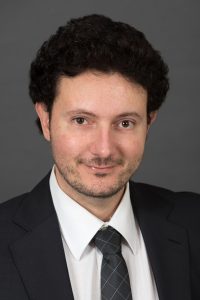
Pietro Genovese, PhD, recipient of an Emerging Scientist Award in 2020
Pietro Genovese, PhD, still has a photo of himself at age 10, dressed up as a scientist with wild white hair and a lab coat. Now he’s living his childhood dream (minus the white hair) as an assistant professor of pediatrics at Harvard Medical School and a researcher with the Gene Therapy Program at Dana-Farber/Boston Children’s Cancer and Blood Disorder Center. And with the help of a 2020 Emerging Scientist Award from Children’s Cancer Research Fund (CCRF), he’s pushing new frontiers in genetic engineering in pursuit of a cure for hard-to-treat childhood cancer.
“I was very honored to receive this award,” he said. “Thanks to the support of Children’s Cancer Research Fund, we have already achieved very significant results.”
Before moving to Boston to start his own lab in 2019, Genovese worked at the San Raffaele Telethon Institute for Gene Therapy in Milan, Italy, where he helped pioneer new genetic engineering techniques and developed the first successful gene editing strategy to correct inherited mutations in human hematopoietic stem cells. Found in blood and bone marrow, hematopoietic stem cells are responsible for generating all the different types of mature blood cells in the body. Now Genovese is using hematopoietic stem cell engineering and advanced gene-editing tools to improve immunotherapies for acute myeloid leukemia (AML).
“I’m very optimistic now because at our institute in Italy, we saw children who were born with immune defects, and most of them received a real and definitive cure,” he said. “This was always the driver of our work. When we see these achievements, it’s very touching, and these moments allow you to really be motivated. What we’ve learned from gene therapy with rare disorders is that these therapies are becoming a real possibility for previously incurable disorders. I think we’re now ready to apply the same technologies to find a new way to cure more common disorders and diseases like leukemias.”
For more about AML, read Jacob's Story - Becoming a Hero.
New treatments for AML are desperately needed: despite drastic improvements in treatments and survival rates in recent years, more than 30% of children with AML still experience dismal outcomes. But genetic engineering could change that.
Advances in genetic engineering have already led to CAR T-cell therapy, which reprograms a patient’s own immune cells to destroy cancer cells. “New hope is coming from new immunotherapy approaches, in particular the ones that utilize T-cells, which provide significant results for other types of leukemia,” Genovese said. “The real problem in applying this strategy in AML is that acute myeloid leukemia stem cells are very similar to normal stem cells, so it’s almost impossible to identify targets that are specific to AML and not normal healthy tissues.”
And killing normal bone marrow cells along with leukemia cells can cause numerous problems, including anemia, low white blood cells, low platelets, and increased risk of infections and hemorrhaging.
But Genovese believes he has a solution: modifying the healthy bone marrow stem cells that patients receive via transplant so they’re more resistant to targeted cancer treatments such as CAR T-cell therapy.
“This is a very innovative approach. Using precise gene editing, we hypothesize that we can change one protein in healthy hematopoietic stem cells and make it invisible to the antibody while preserving its physiologic function,” he explained. “This would allow the administration of highly effective immunotherapies targeting a protein essential for cancer survival without the risk of severe toxicity on the healthy tissue.”
Learn more: Why childhood cancers are considered "too rare" to get research funding
What makes the project especially novel is that it’s more precise and less risky than genetic engineering approaches that “knock out” a particular gene, he said. “Our approach is dramatically different,” he said. “If you can destroy a gene, the cancer cells can destroy the gene and thus become resistant to the therapy. That’s the principal advantage of our approach — not to destroy the gene, but to modify a gene that cannot be disrupted and make it invisible to the targeted therapy."
Transplanting the engineered hematopoietic stem cells would then allow doctors to increase the dose of cancer-killing drugs while still preserving healthy cells, which could lead to better outcomes for children with hard-to-treat AML.
Genovese’s team is making good progress. “We’ve identified the genetic variants of our target protein and hope to achieve proof of concept in one to two years,” he said. “Genetic engineering of hematopoietic cells is a very new technique but is now really close to reaching clinical trials for sickle cell disease, so we can take what we learn from that to accelerate this research.”
And because CAR T-cell therapy is already in clinical testing with AML patients, Genovese’s approach is one step closer to helping patients.
Genovese said that philanthropy has been critical to his momentum, especially as a researcher still early in his career. “Children’s Cancer Research Fund was really essential,” he said. “I moved here to Boston just two years ago, and I started this project from the very beginning. Despite the fact that the ideas are very novel and promising, it is complicated to get enough data to be supported by federal grants. So this funding support was very essential to see that my strategy is working. Once we have the proof of concept, we can apply for larger grant applications that will allow us to move forward.”
Your donations make progress possible.
When you donate to Children's Cancer Research Fund, you make it possible for researchers to uncover how to better prevent and treat childhood cancers. Every $1 donated helps researchers secure $18 in additional funding to make groundbreaking discoveries.





